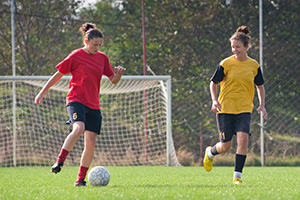Myositis ossificans may sound like a complicated condition, but this abnormal bone-tissue growth is a somewhat common sports injury. Sustained at any level of play or competition, myositis ossificans is the formation of bone tissue inside muscle tissue after a traumatic injury to the area.

This injury usually is the result of an acute deep-muscle bruise or repeated muscular trauma to the same spot, and rarely is caused by a bad muscle strain. After the injury, the body begins to deposit bony tissue instead of muscular tissue at the healing site, eventually causing the formation of a hard lump you can feel.
Formation of the bony tissue is an error in the way the body is trying to heal. By accidentally replacing muscle cells (fibroblasts), with the cells that help form bone (osteoblasts), the body creates a deposit of immature bone inside the muscle tissue. This gradually occurs about two to three weeks after the initial injury.
As the bony mass becomes larger it may become palpable and painful. The mass can limit range of motion for the affected muscles. This can slow the healing process.
No sure-fire way exists to know whether myositis ossificans will occur in you after a muscle injury.
Prompt response to the injury can help prevent a mass from forming:
- The first 24 hours after a deep muscle bruise are critical to the long-term management of the injury. If you suffer this type of injury, you may need to remove yourself from the event to receive immediate medical attention.
- Apply ice packs immediately after the injury occurs and during the next several days. Ice helps decrease swelling of muscle tissue, and gives the tissue a better chance to heal.
-
Light stretching of the injured muscle is highly encouraged. While the stretching shouldn't be painful, the continued use of the muscle helps keep your range of motion from being affected. Myositis ossificans is more likely to develop in a sedentary muscle.
Treatment for myositis ossificans tends to be conservative. Usually treatment begins with NSAID (non-steroidal anti-inflammatory drug) medication such as ibuprofen, which helps reduce swelling. Topical treatments, such as Biofreeze® or Icy Hot®, help reduce pain. You may continue to exercise or play with this injury. But wear protective padding on the injured area to ensure no more hits occur that could cause the bony deposit to increase in size.
If the problem persists, treatment may include physical therapy for stretching and strengthening exercises to help decrease the size of the bony-tissue deposit. Physical therapists also may use a therapeutic ultra-sound machine to break up the bony growth. This makes it easier for the body to reabsorb the bony tissue and form healthy muscle tissue.
Rarely is surgery needed to remove the bony deposit. If the calcification is removed too early and before it’s mature (usually between six to 12 months), it’s highly likely the deposit will again form in the muscle. Surgery is considered if the deposit is causing excessive pain or compressing a nerve, or if it greatly interferes with your range of motion.
Share comments or questions on this information email: sports.medicine@marshfieldclinic.org.
